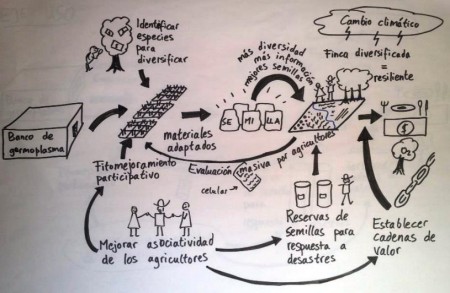Our friend and occasional contributor Jacob van Etten has been busy. He has a piece out over at the CCAFS blog describing his work in India on crowdsourcing the evaluation of wheat varieties in the context of climate change adaptation which has been attracting some attention. He’s blogged here before about getting seeds out to farmers, but he’s also published a bit more formally on the subject, and seems now to be putting his theories into practice now at Bioversity. More power to him. If you’d like to hear him explaining his work, rather than just reading about it, you can do that too.
A bit surprisingly, Jacob doesn’t particularly highlight 1 the role of genebanks in his CCAFS piece. It would be interesting to know why. Perhaps he can tell us here. Or on his Twitter account. Anyway, I’ve found a diagram on his Facebook page which suggests that he does think genebanks have a key role to play in diversified and resilient farming systems. Here it is, for those of you who are not his “friends.”

Interesting. During and since the years of fighting and disruption here in Burundi, seed sourcing by farmers has been primarily through 2 channels – informal (own, traded, purchased, etc) – and/or seed distribution programs, which I discussed a bit in my last blog on beans. But the entire network remains in fair disruption and there are still major attitudes of ‘distribution mentality’ at producer, national, and donor levels.
This is the latest iteration on seed security…
Is that available anywhere outside the paywall? Maybe you could ask Louise to share a preprint.
Well, the piece you refer to is about wheat in India. The Green Revolution started for real with wheat in India, so you could guess that enough varieties are available. But farmers in Bihar have few of those in their fields and little access to quality seed. So this seemed a low hanging fruit to my colleague in India, Prem Mathur.
In other places, where improved varieties are few and not very suitable to farmers, we use materials from genebanks. For instance, in Ethiopia as explained by my colleague Carlo Fadda. In East Africa, we are going to do crowdsourcing, too.
The poster is an intermediate version of one part of a bigger plan to make seeds work for farmers in Central America. Obviously, genebanks play a big role in this plan and not only as suppliers of materials, but also to custody and curate diversity. Yet another colleague made a poster on that…
Great info you all! I am in a graduate seminar Ethnobiology and Conservation at University of Hawai’i. I am responsible for finding a couple of articles on Traditional Ecological Knowledge and Climate Change. I’d love to have one that relates to agriculture and agrobiodiversity. Anything come to mind?
And also, perhaps of interest to you and readers:
http://ethnobiology.org/conference/upcoming
Thanks Jay. You might find something of interest in this book: Tropical fruit tree species and climate change.